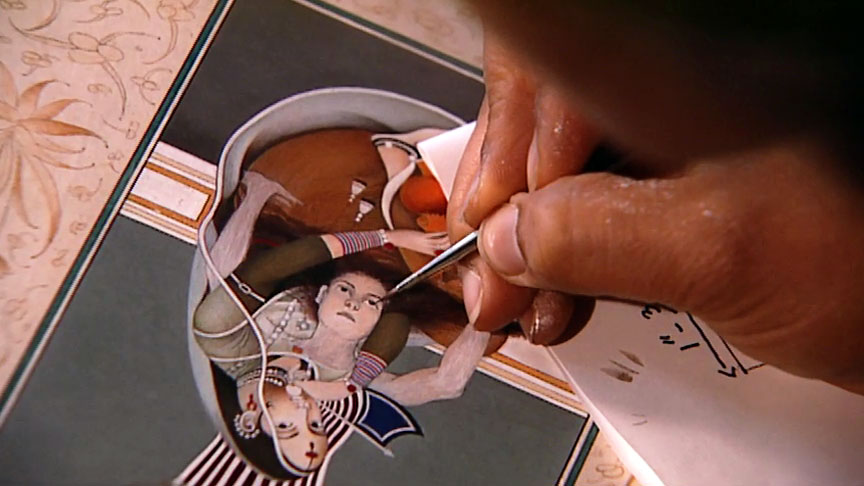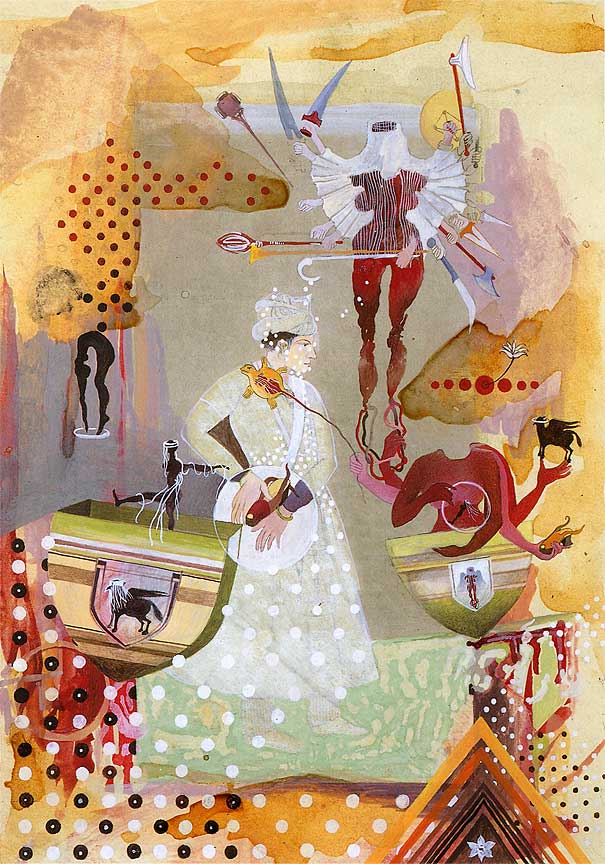Interview
Islam and Miniature Painting

Production still from the Art in the Twenty-First Century Season 1 episode, Spirituality. © Art21, Inc. 2001.
In this interview, conducted with Shahzia Sikander and the artist’s mother, the two discuss Sikander’s early interest in art, and the ways in which her work addresses and confronts women’s roles in society.
ART21: Were you interested in art as a child? Do you have any childhood memories of knowing you wanted to be an artist?
SIKANDER: I think a lot of my memory is always associated with friendships and relationships. It’s very much about people. I was very interested in portraiture. How I started doing drawings was that I could draw somebody’s face and give that as a present to them, to maybe win their affection . . . (LAUGHS) For primarily those reasons, as a child even, and the pleasure to be able to draw somebody’s portrait to perfection—and still, most of my work deals with that. It’s like, people you want to identify with, artists you want to identify with, people who’ve had a significant part in my life—they come into my work. So, I was looking at an art form which did not deal very much with the personal, and then that was what I was interested in: how to make a personal expression in this genre, which was very thematic. So, it really evolves around feelings and experiences I’ve had in life with people.
ART21: Did you know you were breaking with the tradition of miniature painting when you began working, including personal subjects or ideas in this genre?
SIKANDER: No, because there was no particular way of defining the tradition, either. Miniature painting, at least at school, was offered as a place of experimentation. So again, when you think about it as this traditional art form, you tend to bring all this baggage that you’re dealing with, a very specific way of working. But when you are offered miniature painting at a school, it’s a place of experimentation. Not too much and not too little—it was controlled. You weren’t free to just do whatever. You still had to work within a certain set of rules. So, there was no particular break from tradition, and yet my whole purpose of taking on the subject was to break the tradition, to experiment with it, to find new ways of making meaning, to question the relevance of it. So, the intention was that.
ART21: Your art seems to deal with women’s roles.
SIKANDER: I think that also has a lot to do with my personal experience with my extended family. I feel very lucky, very privileged to have had this experience because my grandfather was very encouraging towards careers for women. Like, my cousins, everybody, all the girls in the family did something with their lives. They are still very active people. And one grew up with that very much present. So, I knew that I had to do something constructive. And it wasn’t necessarily geared towards a career, making money, or something that would be considered safe. And I know my mom was, like, “Study architecture,” primarily for those reasons, because it would become functional, whereas painting was still very shaky. But when I was making these choices, nobody was questioning. Even the choice of coming to the U.S. was very much supported by my father and my mother, but it was based on my finding a means of being here. They couldn’t support me to come here.
ART21 (addressing Sikander’s mother): It’s such a pleasure that you could be here as well for this interview—two women from this strong family of women. Was Islam, or being Muslim, a major influence on the family?
MOTHER: Well, it’s a way of life that isn’t any different. I mean, there are certain norms that you go by, and that’s a part of your life. Actually, Islam is a way of life. You can’t separate it. It just tells you how to live your life, in all spheres, relating to all aspects.

Shahzia Sikander. Hood’s Red Rider #2, 1997. Vegetable color, dry pigment, watercolor, tea on hand-prepared Wasli paper; 10 1/8 × 7 1/8 inches. Photo by Tom Powel. Courtesy of Sikkema Jenkins & Co., New York.
ART21: Could you give an example?
MOTHER: Why don’t you ask her? (LAUGHS)
SIKANDER: When I was talking earlier about childhood memories, there are very distinct memories about this aspect, which was a celebration of religion, if you might say so. I remember, when we used to fast, it would be such a celebration. As children, we’d be encouraged; my grandparents would be fasting, and it would be such a joy to get up at night and have food in the middle of the night, and have food at the end of the day. And then you did that—you grew up conditioning yourself to that experience, looking forward to that month. And it was very normal for me, and even now, from a distance. When I fast here, it gets harder because there’s no particular context, and you start questioning.
It’s interesting how the context is so important for everything. And then questioning leads to whatever decisions one wants to make. And mine have been that I still fast. And for that, it’s very relevant for my personal strength, which is still linked to the history of having had that experience from early childhood until the present. And if that brings a certain sense of anchoring or nurturing, then maybe that is coming from this aspect of what we decide is religion or what we define as religion.
You know, there’s some discipline there; it’s in the act of fasting and the act of taking that month out and abstaining yourself from certain aspects of life. And then it’s very, very empowering. But it does not become an issue because it comes naturally, and coming naturally because I was conditioned early on in life. And while I was being conditioned, it was made an enjoyable aspect. And in the same sense, saying prayers has a sort of significance for me. It becomes a personal and yet collective sort of experience. And again, I hold that. I think family is responsible for that—growing up with grandparents, definitely. I meet people here who come from very religious families, and they have a hard time dealing with religion.
I never thought I came from a religious background. And things I do might be considered religious, but it’s so much what you are comfortable with. For me, I’ve had a lot of freedom in understanding Islam, and it gives me strength, and it’s very progressive, and I understand it with that sense. I cannot relate to any sense of oppression from the religion. And that’s not the general concept, especially here, which anything and everything associated with Islam is either terrorism or oppression for women. So, right there: Where do you begin? How do you counter that? What do you say? And I think a lot of it is also because I went to a convent school, so I grew up understanding Christianity. As a Muslim, I have to understand Christianity; I have to understand Judaism. I need to know.
And so, I grew up as a kid respecting God and having knowledge. When I come here, people don’t even know the difference between Hindu or Muslim, for instance. It’s, like, so simplistic and simplified. And of course, we live in a place where we are encountering stereotypes, and we have our own counter-stereotypes. So, it’s just the nature of things, how they happen in history. Again, my experiences of religion is from how it was given to me from my parents and grandparents.
ART21: Do you see any links between praying and fasting—practicing your religion—and the process of making art?
SIKANDER: I think the hard part is when you’re out of practice.
ART21: The hard part of what?
SIKANDER: Oh, the hard part of the lack of discipline is when I feel less productive. Like, if I am painting regularly, and there is a certain structure and certain discipline that is being brought into the studio, my mind works better; I have better ideas. I’m able to accomplish far more. I’m able to move on to the next stage. But the minute that discipline leaves the studio, everything gets very scattered. And even times in life, when things have gone to extremes, I do get back into a certain notion of spirituality, where I need to be by myself, or I need to read, or I will fast, or I will do things which make sense to me, and which allow me to come back to that space.
So, the same way, when I am working large and I paint and I do murals, and the next thing is I come back to miniature painting. It’s just this whole dichotomy of experience. I do always come back to miniature. I can hate miniature for a while, and I want to move ahead because it’s frustrating, because of all the different reasons of doing something so labor intensive without much critical structure, which becomes [exoticized], and which takes years to make. So, it’s like always: “Why do I do this?” And I let go and do something else. But I always come back to it, and maybe because by the sheer act of doing it is what gives me a certain sort of peace.
This interview was originally published on PBS.org in September 2003 and was republished on Art21.org in November 2011.



